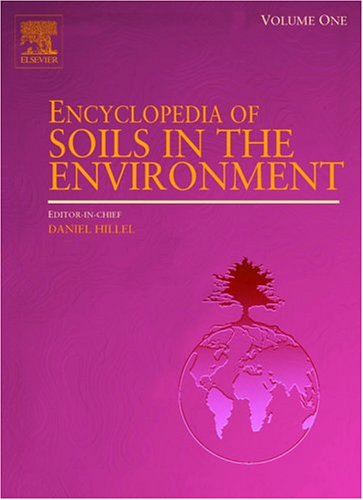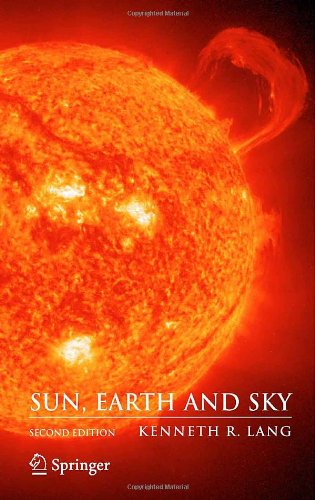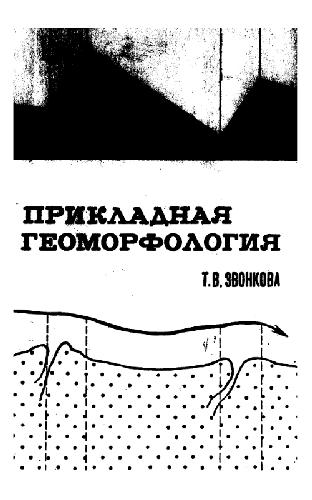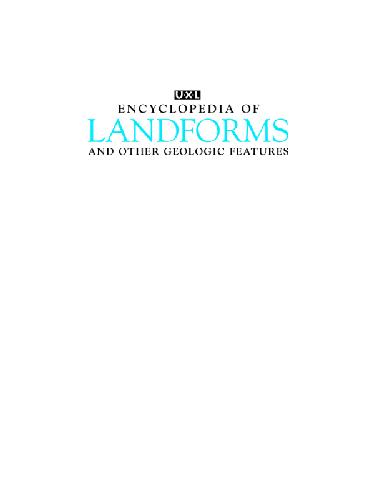Daniel Hillel9780123485304, 0123485304, 0123485312, 0123485320, 0123485339, 0123485347
Table of contents :
Cover Page……Page 1
Book Description……Page 2
EDITOR-IN-CHIEF……Page 3
EDITORS……Page 4
EDITORIAL ADVISORY BOARD……Page 5
FOREWORD……Page 6
PREFACE……Page 7
INTRODUCTION……Page 9
B……Page 10
C……Page 11
D……Page 12
F……Page 13
G……Page 14
J……Page 15
M……Page 16
P……Page 18
R……Page 20
S……Page 21
T……Page 22
W……Page 23
Z……Page 24
Aggregation ……Page 25
Aluminum Speciation ……Page 26
Applications of Soils Data ……Page 27
Bacteria ……Page 28
Buffering Capacity ……Page 29
Carbon Emissions and Sequestration ……Page 30
Civilization, Role of Soils ……Page 31
Classification Systems ……Page 32
Climate Change Impacts ……Page 33
Compaction ……Page 34
Cover Crops……Page 35
Crusts……Page 36
Degradation ……Page 37
Disinfestation ……Page 38
Electron-Spin Resonance Spectroscopy……Page 39
Enzymes in Soils……Page 40
Erosion……Page 41
Evaporation of Water from Bare Soil ……Page 42
Factors of Soil Formation……Page 43
Fauna……Page 44
Acid Rain……Page 45
Wet oxidation of sulfur……Page 46
Acid Soil……Page 47
Carbonic and organic acid production……Page 48
Observations of Changes in Soil Acidification due to Acid Deposition……Page 49
Proton Sinks and Buffer Ranges……Page 50
Cation Exchange Buffer……Page 51
Aluminum and Iron Buffer……Page 52
Acidification, Ecosystem Stability and Global Change……Page 53
Introduction……Page 55
Acid Precipitation……Page 56
Elemental Cycling……Page 57
Fertilizer Reactions……Page 58
Measurement and Effects of Soil Acidity……Page 59
Amelioration of Soil Acidity……Page 60
Soil-Air Composition……Page 61
Convection……Page 62
Production and Consumption of Other Gases……Page 63
Summary……Page 64
Further Reading……Page 65
Microorganisms and Aggregate Formation……Page 66
Soil Aggregates as Habitats for Microbiota……Page 69
Protection of Organic Matter Conferred by Soil Aggregates……Page 70
Soil as a Spatially Continuous Medium……Page 71
Physical Aspects……Page 72
Forces on Soil Particles……Page 73
Basic Properties……Page 75
Commonly used methods……Page 76
Representation and Interpretation……Page 77
Further Reading……Page 78
Emergence of Agroforestry as a Land-Use Approach……Page 79
Agroforestry Systems……Page 80
Alley Cropping……Page 82
Homegarden, Shaded-Perennial, and Multistrata Systems……Page 83
Silvopastoral Systems……Page 84
Other Agroforestry Applications……Page 85
Carbon Sequestration……Page 86
Acknowledgments……Page 87
Further Reading……Page 88
Texture……Page 89
Landforms……Page 90
Older Alluvial Soils……Page 91
Human Use of Alluvial Soils……Page 92
Further Reading……Page 93
Inorganic Aluminum Species in Soil Solution……Page 94
Organic Complexes of Aluminum……Page 95
Fractionation Based on Size, Charge, and Reactivity……Page 97
Speciation Using More Direct Analytical Methods……Page 98
Introduction……Page 100
Retention of Ammonia by Soils……Page 101
Reactions of Urea in Soils……Page 103
Urea concentration……Page 104
Soil urease concentration……Page 105
Reactions of NH4+-N Applied to Calcareous Soils……Page 106
Further Reading……Page 107
Occurrence in Soils……Page 108
Identification……Page 109
Structure and Charge……Page 111
Chemisorption and Ligand Exchange……Page 112
Aluminum Solubility……Page 114
Further Reading……Page 115
Physical Characteristics……Page 116
Chemical Characteristics……Page 117
Biogeochemical Characteristics……Page 118
Microbial Respiration……Page 119
Agronomic, Ecologic, and Environmental Significance……Page 121
Development of Interpretations in the USA……Page 122
Interpretations Beyond Agriculture……Page 124
Recreation……Page 125
Federal and State Programs……Page 127
Land Appraisal and Assessment……Page 128
Research and Analyses……Page 130
Introduction……Page 132
The Archaeal Cell……Page 133
Extreme Halophiles……Page 134
Methanogens……Page 135
Hyperthermophiles……Page 136
Biotechnological Use of Extremoenzymes……Page 137
Further Reading……Page 138
Pedostratigraphy and the Archeological Record……Page 139
Archeological Soil Chemistry……Page 141
Soil as a Resource……Page 142
Further Reading……Page 145
Plant Growth-Promoting Bacteria in Agriculture and the Environment……Page 147
Biocontrol of Phytopathogens……Page 152
Production of Antibiotics……Page 153
Production of Enzymes……Page 154
Competition and Displacement of Pathogens……Page 155
PGPB Inoculants……Page 156
Conclusions and Prospects……Page 157
Further Reading……Page 158
Bacterial Diversity……Page 159
The Microbe as the Scale of Study……Page 160
Avoidance……Page 161
Extracellular Polysaccharide Production……Page 162
Competition for Resources……Page 163
Quorum-Sensing……Page 164
Summary……Page 165
Why Soil Bacteriophage?……Page 166
The Role of Phage in Horizontal Gene Transfer and Bacterial Evolution……Page 167
Evidence for Natural Transduction in Microbial Communities……Page 168
Microscopy of Soil Viruses……Page 169
Genomic Approaches to Viral Diversity……Page 171
Further Reading……Page 172
Introduction……Page 173
Organic Amendments……Page 174
Selection, Evaluation, and Delivery of Microbial Biocontrol Agents……Page 175
Parasitism……Page 177
Future Prospects……Page 178
Further Reading……Page 179
Diversity and Abundance……Page 180
Distribution……Page 182
Soil Biodiversity and Ecosystem Functioning……Page 183
Global Change and Impacts on Soil Biodiversity……Page 184
Further Reading……Page 185
The Samovar Analogy for Buffering in Soils……Page 186
Buffering of Soil Acidity……Page 187
Cation Exchange Reactions and pH Buffering……Page 188
pH-Dependent Surface Charge and pH Buffering……Page 189
Buffering of Ion Activities via Dissolution-Precipitation, Ion Exchange, and Ligand Complexation……Page 190
Further Reading……Page 191
Input to Soils……Page 193
Modeling the Dissolution Reactions of Calcium and Magnesium Compounds in Soils……Page 195
Plant Requirements and Deficiency Symptoms……Page 196
Animal Requirements……Page 197
Further Reading……Page 198
Contact Angle……Page 199
Curved Surfaces and Capillarity……Page 200
The Capillary Rise Model……Page 201
Capillarity in Angular Pores……Page 202
Dynamics of Capillary Rise……Page 203
Dynamic Contact Angle……Page 204
Contact Angle on Chemically Heterogeneous and Rough Surfaces……Page 205
Further Reading……Page 207
Introduction……Page 208
Functions……Page 210
Regulation of Soil Organic Carbon Dynamics……Page 211
Management……Page 212
Sources of Carbon……Page 214
Aerobic Decomposition……Page 215
Anaerobic Decomposition……Page 216
Factors Controlling Decomposition……Page 217
Soil Organic Matter Formation and Turnover……Page 218
Soils and Carbon-Cycling……Page 219
Controls on Emissions and Sequestration……Page 220
Land Use and Land-Use Change……Page 221
Management Practices for Soil C Sequestration……Page 222
List of Technical Nomenclature……Page 223
Introduction……Page 224
Cation Exchange Capacity……Page 225
Properties of Ions……Page 226
Properties of Solvents……Page 227
Homovalent Binary Exchange……Page 228
Heterovalent Binary Exchange……Page 229
The Future of Cation Exchange……Page 231
Further Reading……Page 232
Free-Energy Definition……Page 233
Limitations to Equilibrium in Soils……Page 234
Reactions and Associated Equilibrium Constants……Page 235
Iron Oxides in Reduced Systems……Page 236
The Outlook for Studying Chemical Equilibrium in Soils……Page 237
Further Reading……Page 238
Childs, Ernest Carr……Page 239
Further Reading……Page 242
Historical Attitudes Toward the Soil……Page 243
Human Origins……Page 244
The Agricultural Transformation……Page 245
Soil Husbandry and Ceramics……Page 246
The Sustainability of Egyptian Agriculture……Page 247
Classification of Soils……Page 248
Principle of Domain……Page 249
Principle of Differentiation……Page 250
Principle of Prioritization……Page 251
Principle of Membership……Page 253
Further Reading……Page 254
History of General-Purpose National Soil Classifications……Page 255
The New National Classification……Page 256
State and Regional Examples……Page 257
Engineering Applications: Laying of Telecommunication Optical Fiber Cables……Page 258
The Development of the FAO Legend 1960-—1981……Page 260
Set 4……Page 262
The FAO Revised Legend 1981-1990……Page 263
The World Reference Base for Soil Resources 1981-1998……Page 264
Further Reading……Page 266
Early Systems……Page 267
Official Systems……Page 268
Russian soil classification system – 1997……Page 269
Introduction……Page 271
Agroproductive Soil Groups, Folk Soil Nomenclature, and First Scientific Soil Classifications……Page 272
Genetic Approach to Soil Classification……Page 273
Diversification of Classification Decisions……Page 274
The Problem of Basic Substantive-Genetic-Soil Classification and the new Russian Classification……Page 276
Introduction……Page 279
Soil Composition……Page 280
Genesis and Soil Taxonomy……Page 281
Climate Zones in Soil Taxonomy……Page 282
How it Works……Page 284
Example Profile……Page 286
Further Reading……Page 289
Tetrahedra and Octahedra……Page 290
Octahedral Sheet……Page 291
Halloysite……Page 292
Micas……Page 293
Hydroxy-interlayered vermiculite and smectite……Page 295
Other Minerals that Occur in Soil Clays……Page 296
Carbonates, Sulfates, and Soluble Salts……Page 297
Climate Change Predictions……Page 298
Soil Water……Page 299
Soil Organic Matter……Page 301
Acidification and Nutrient Status……Page 302
Desertification……Page 303
Climate Change Impacts on Soil Functions……Page 304
Approaches to Modeling SOC Dynamics for the Study of Climate Change……Page 306
Factors Affecting the Turnover of Soil Organic Carbon in Models……Page 307
Climate Models with Coupled Description of Biospheric Carbon Feedbacks……Page 308
Further Reading……Page 311
Definition of Cold Soils……Page 312
Alpine and high arctic soils……Page 313
Morphological Properties……Page 314
Biological and Chemical Properties……Page 315
Alpine and Plateau Regions……Page 316
Land Use of Cold-Region Soils……Page 317
Agriculture Development……Page 318
Further Reading……Page 319
Nature and Stability of Soil Colloids……Page 320
Colloid Transport in Porous Media……Page 323
Factors Influencing Colloid Release……Page 324
Factors Influencing Colloid Deposition……Page 325
Colloid-Facilitated Transport of Contaminants……Page 327
Further Reading……Page 328
Loading Characteristics of Individual Wheels or Caterpillar Tracks……Page 329
Field Traffic Intensity and Distribution……Page 330
Hydraulic Properties……Page 331
Compaction in Crop Production……Page 332
Crop Responses to Subsoil Compaction……Page 333
Effects on Environmental Components……Page 334
Techniques for the Reduction of Compaction……Page 336
Further Reading……Page 337
Compost Production……Page 338
Compost Application and Incorporation……Page 339
Physical Effects……Page 340
Chemical Effects……Page 341
Biological Effects……Page 343
Further Reading……Page 344
Early Use of Mineral and Organic Materials……Page 345
Advent of Synthetic Conditioners……Page 346
Hydrogels and Super Water-Absorbent Polymers……Page 347
Recent Advances Using Polyacrylamide……Page 348
Further Reading……Page 349
Evolution of Conservation Tillage Systems……Page 350
Variants of Conservation Tillage……Page 351
High Levels of Crop Residue……Page 352
Enhancing Soil Organic Matter Storage……Page 353
Further Reading……Page 354
Introduction……Page 355
Species Selection……Page 356
Seeding and Husbandry……Page 357
Role in Soil Quality Improvement……Page 358
Nature of Soil Erosion……Page 359
Perspective……Page 360
Further Reading……Page 361
Introduction……Page 362
Soil Fertility and Crop Yields……Page 363
Pest Management with Rotations……Page 364
Future Perspectives……Page 365
Introduction……Page 366
Crop Evapotranspiration……Page 367
Crop Coefficients……Page 368
The Single-Crop Coefficient Approach……Page 369
The Dual-Crop Coefficient Approach……Page 374
Summary……Page 376
List of Technical Nomenclature……Page 377
Conservation, Carbon Cycle, Soil Organic Matter and Carbon Sinks……Page 378
Crop Residues and Nutrient Cycling……Page 379
Crop Residues: Social and Environmental Benefits……Page 380
Summary……Page 381
Further reading……Page 382
Species Composition and Growth Forms……Page 383
Nitrogen Fixation……Page 385
Soil Hydrology and Stabilization……Page 387
Wind Erosion……Page 388
Conclusion……Page 389
Introduction……Page 391
Crust Types and Morphology……Page 392
Rainstorm Characteristics……Page 393
Hydrologic Impact of Crusts……Page 395
Infiltration – Developing Crusts……Page 396
Numerical Infiltration Models for Developing Crusts……Page 397
Agronomic Importance of Crusts……Page 398
Further Reading……Page 399
Goals of Soil Tillage……Page 400
Disadvantages and limitations……Page 401
Disk Harrow……Page 402
No-tillage……Page 403
Types of Tillage Systems……Page 404
Further Reading……Page 405
Water-Saturated Soil Conditions……Page 407
Validity of Darcy’s Equation……Page 408
Water in Unsaturated Soils……Page 410
List of Technical Nomenclature……Page 412
Further Reading……Page 413
Factors and Processes Affecting Degradation of Soils……Page 414
Approaches……Page 415
Potentials and Limitations……Page 417
Degree of Degradation……Page 418
Preventing and Combating Degradation……Page 419
Further Reading……Page 421
Denitrification……Page 422
Nitrifier Denitrification……Page 423
Controls on O2 Availability……Page 424
Conclusion……Page 425
Introduction……Page 426
The Role of Drought……Page 427
Primary Production and Carrying Capacity……Page 428
Potentialities and Problems of Irrigation……Page 429
Monitoring Desertification……Page 430
Overview……Page 431
Further Reading……Page 432
How Diffusion Occurs……Page 433
Components of the Diffusion Coefficient in Soil……Page 434
Diffusion from a Semiinfinite Medium……Page 435
Simple Model for Various Geometries……Page 436
List of Technical Nomenclature……Page 437
Introduction……Page 438
Physical……Page 439
Application……Page 440
Principles of soil solarization……Page 441
Combining Disinfestation Methods……Page 442
Further Reading……Page 443
Introduction……Page 444
Kinetics of Proton- and Ligand-Promoted Mineral Dissolution……Page 445
Metal-Promoted Mineral Dissolution……Page 447
Dissolution of Metal Surface Precipitates……Page 448
The Good and Bad of Dissolution Kinetics……Page 451
List of Technical Nomenclature……Page 452
Introduction……Page 453
Surface Drainage Principles and Practices……Page 454
Subsurface Drainage Principles and Practices……Page 455
Recent Innovations in Drainage Practice……Page 456
Further Reading……Page 457
World Scope of Dryland Farming……Page 458
Fallowing……Page 459
Water Retention Management……Page 460
Further Reading……Page 461
Edaphic Properties……Page 463
Edaphic Factors Affecting Water and Air……Page 464
Edaphic Factors Affecting Plant Nutrients……Page 465
Edaphic Factors Affecting Root Growth……Page 467
List of Technical Nomenclature……Page 468
Further Reading……Page 469
Spectral Parameters……Page 470
The Instrument and the Experiment……Page 471
Sample Preparation……Page 472
Whole Soil……Page 473
ESR Spectra and Parameters……Page 474
Structural Implications……Page 475
ESR Spectra and ESR Parameters……Page 476
Ferric iron……Page 477
Divalent copper……Page 478
Complexation chemistry of humic substances……Page 479
List of Technical Nomenclature……Page 480
Further Reading……Page 481
Energy Balance of the Earth’s Surface……Page 482
Introduction……Page 485
Why Monitor Soils?……Page 486
The Starting Point……Page 487
Monitoring Sites……Page 488
Soil Sampling……Page 490
Further Reading……Page 491
Introduction……Page 492
Microscale Distribution……Page 493
Methods of Studying Enzyme Activities in Soils……Page 494
Enzyme Kinetics……Page 495
Sensitivity to Soil Management and Ecosystem Stress……Page 496
Detoxification of Polluted Soils……Page 498
Further Reading……Page 499
Introduction……Page 500
Significance……Page 501
Processes Causing Soil Loss……Page 502
Soil and crop management practices……Page 503
Irrigation practices……Page 504
Runoff management practices……Page 505
Summary……Page 506
Introduction……Page 507
Gully Erosion……Page 508
Topography……Page 509
Forest areas……Page 510
Terraces……Page 511
Grassed waterways……Page 512
Further Reading……Page 513
Modes of Transport……Page 514
Soil Surface Conditions……Page 515
Wind Erosion Modeling……Page 517
Wind Erosion Sampling……Page 518
Effects of Wind Erosion……Page 519
Wind Erosion Control……Page 520
Further Reading……Page 521
Nutrient Deficiency Symptoms……Page 522
Nitrogen……Page 523
Phosphorus……Page 524
Calcium……Page 525
Iron……Page 526
Copper……Page 527
Boron……Page 528
Further Reading……Page 529
Limiting Nutrients……Page 530
Changes in Species Composition……Page 533
Sea-Grass Destruction……Page 534
Terrestrial Eutrophication……Page 535
Watershed Export and Models……Page 536
Controlling Eutrophication: Future Trends……Page 537
Evaporation Rate and Cumulative Evaporation……Page 538
Energy Balance……Page 539
Stages of Evaporation……Page 540
Evaporation Below the Soil Surface……Page 541
Weigh the Loss of Water Mass in the Soil……Page 542
Measure Enough Elements in the Energy Balance to Calculate LeE……Page 543
Compare the Soil of Interest to a Completely Dry Soil……Page 544
List of Technical Nomenclature……Page 545
Development of the Concept……Page 546
Magnitude of Evapotranspiration……Page 547
Control of Evapotranspiration……Page 548
Climate Change and Evapotranspiration……Page 549
Further Reading……Page 550
The Biosequence……Page 551
Vegetation as a Soil-Forming Factor……Page 552
Grassland-Forest Biosequence……Page 554
Conifer Forest-Deciduous Forest Biosequence……Page 555
Introduction……Page 556
Soils in Tropical Climates……Page 558
Soils in Dry Climates……Page 559
Soils in Warm Temperate Climates……Page 560
Soils in Cool Temperate Climates……Page 561
Soils as Climatological Archive……Page 562
Further Reading……Page 563
Scales and Scope of Human Impacts on Soil Formation……Page 564
Evaluating Human Impacts on Soil Formation……Page 566
Agriculture……Page 567
Cities and Industry……Page 569
Mining……Page 571
Climate Change and Soil Formation……Page 573
Significance and Future of Human Impacts on Soil Formation……Page 574
Further Reading……Page 575
Soil-Forming Factors……Page 576
Weathering……Page 577
Influence of Parent Materials in Soil Genesis……Page 578
Further Reading……Page 579
Key Soil Properties that Vary with Time……Page 580
List of Technical Nomenclature……Page 582
Saprovores and Microbivores……Page 583
Predators and Omnivores……Page 585
Decomposition and Nutrient Cycling……Page 586
Soil Modification……Page 588
Further Reading……Page 592







Reviews
There are no reviews yet.